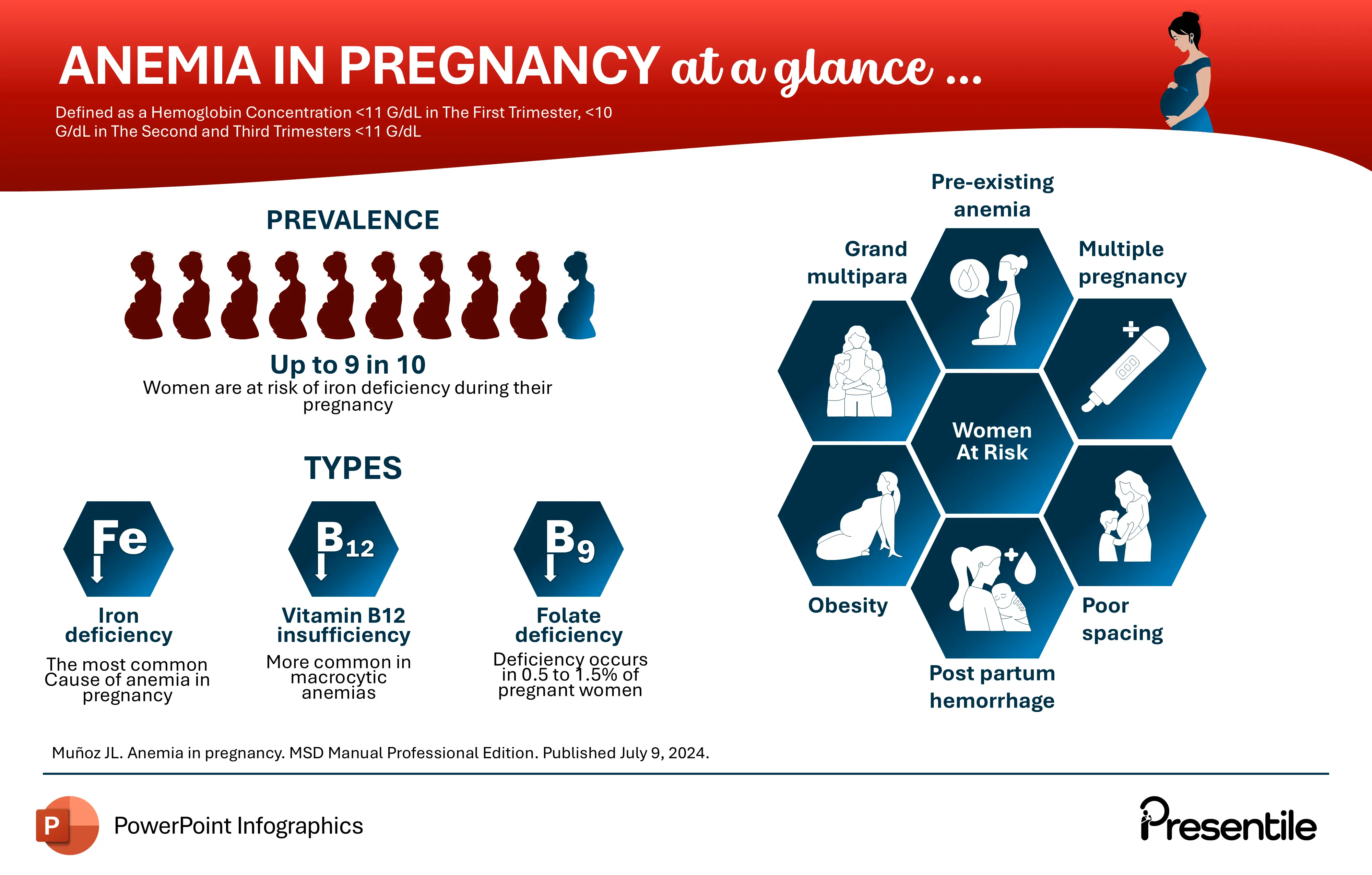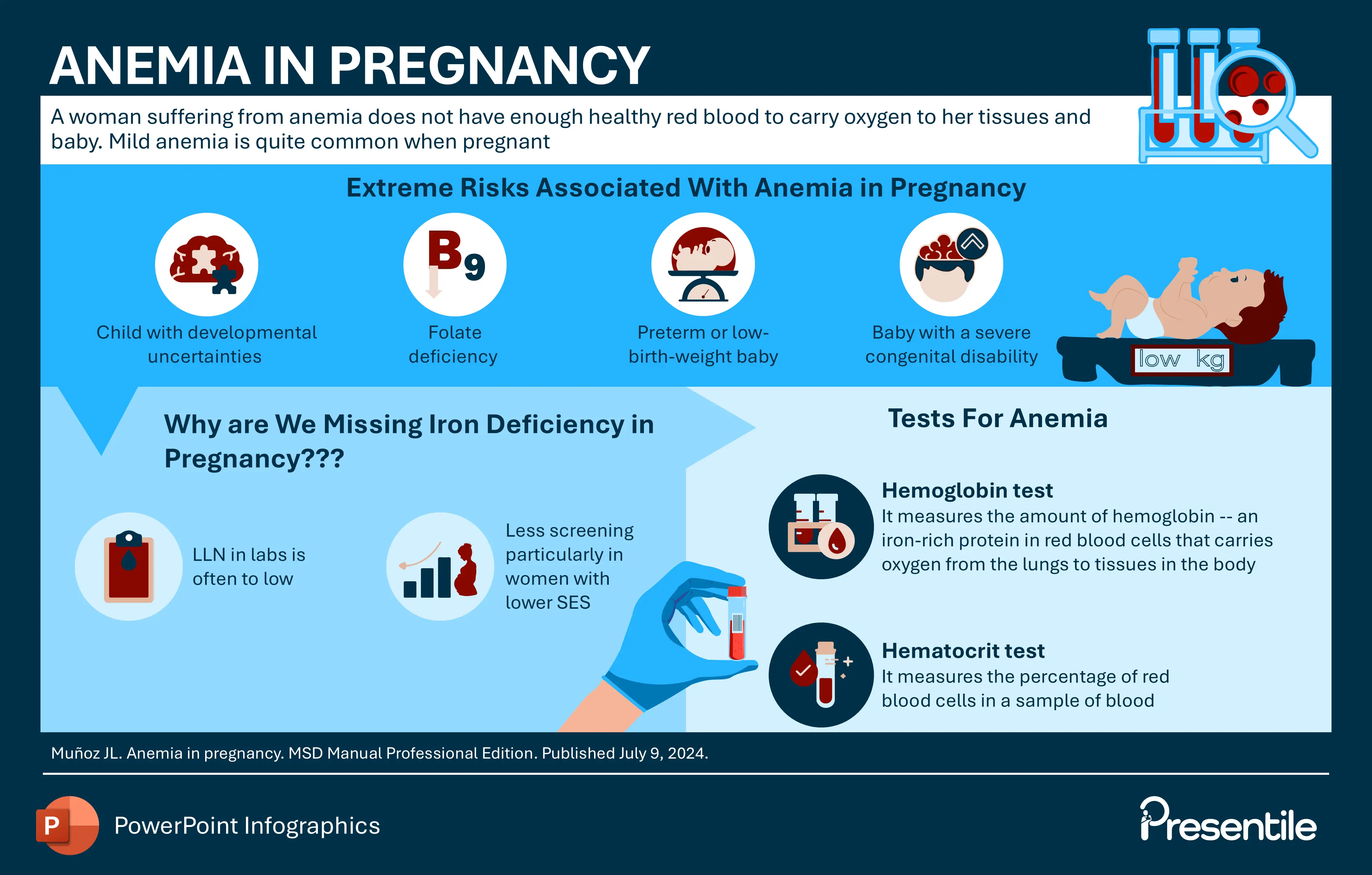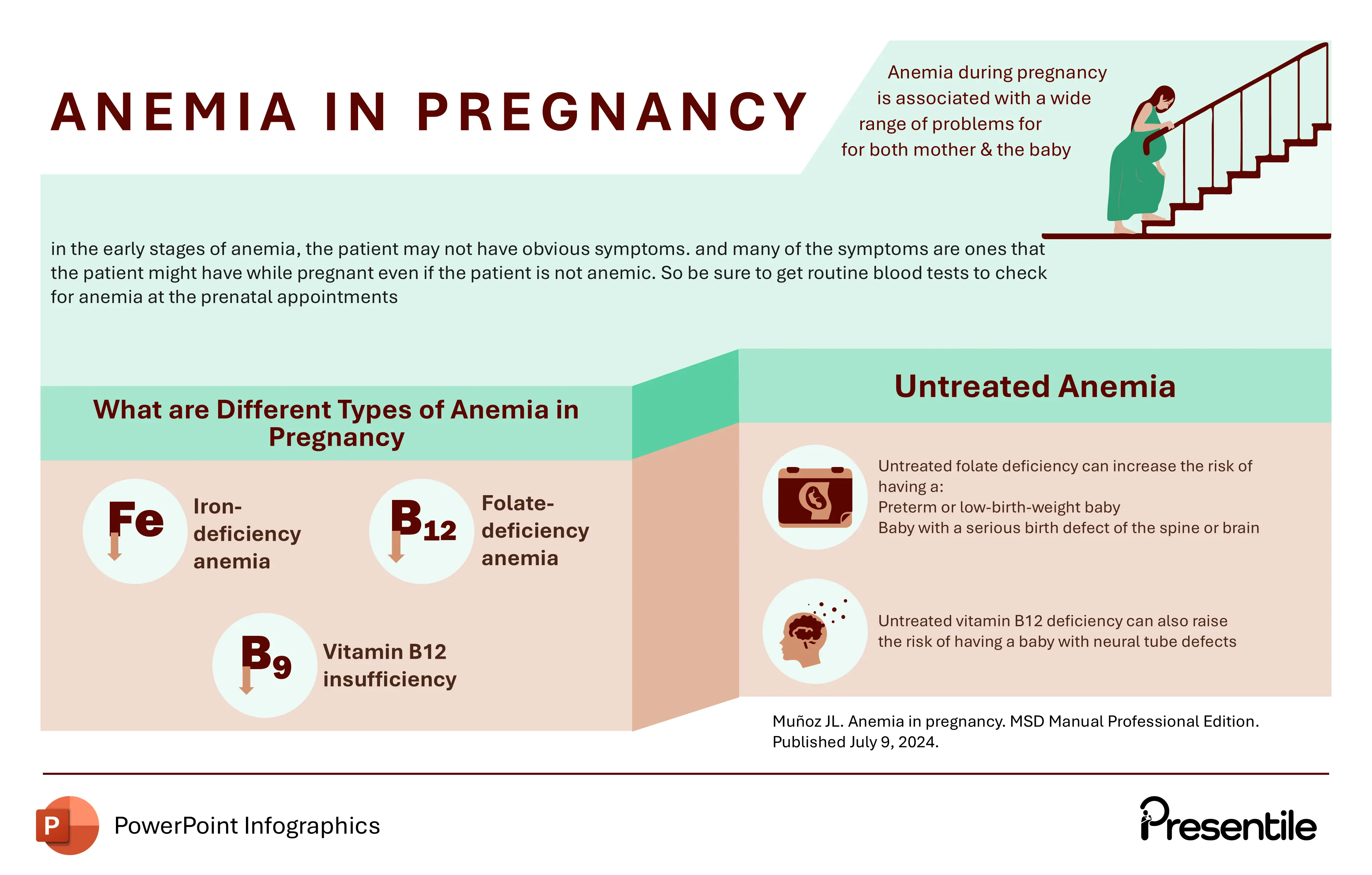
Content of
Anemia in Pregnancy PowerPoint Infographics
Infographic 1: Iron Deficiency Anemia in Pregnancy

- This infographic highlights the potential consequences of iron deficiency anemia during pregnancy.
- It illustrates that low iron levels in pregnant women can lead to increased blood loss during delivery, reduced physical and mental well-being, low birth weight or premature birth in the baby, and impaired brain development in the infant.
- The infographic also emphasizes the prevalence of iron deficiency anemia in pregnancy, stating that it affects 50–77% of all pregnant women.
- Furthermore, it lists common symptoms associated with iron deficiency anemia, including brain fog, fatigue, restless legs, and pica (an abnormal desire to eat non-food substances).
Infographic 2: Anemia in Pregnancy An Overview

- This infographic provides a comprehensive overview of anemia in pregnancy, defining it as a hemoglobin concentration below specified levels in each trimester.
- It highlights that up to 9 in 10 pregnant women are at risk of iron deficiency anemia.
- The infographic explores various types of anemia, including iron deficiency, vitamin B12 insufficiency, and folate deficiency.
- It also identifies risk factors for anemia in pregnancy, such as pre-existing anemia, grand multiparity, multiple pregnancies, obesity, poor spacing between pregnancies, and postpartum hemorrhage.
Infographic 3: Anemia in Pregnancy Prevalence and Early Symptoms

- This infographic provides an overview of Anemia in Pregnancy, highlighting its prevalence and early symptoms.
- It defines anemia in pregnancy as a common disorder experienced by women during gestation.
- The infographic states that an estimated 37% of pregnant women are affected by anemia.
- It lists early symptoms of anemia, including fatigue, weakness, lightheadedness, and mild dyspnea during exertion.
- It also notes that in cases of severe cardiopulmonary symptoms like dyspnea, tachycardia, and tachypnea, further evaluation and treatment are necessary.
Infographic 4: Prevalence and Effects of Anemia in Pregnancy

- This infographic highlights the prevalence and effects of anemia in pregnancy on both the mother and the fetus.
- It states that anemia occurs in up to one-third of women during the third trimester.
- The infographic outlines the potential effects of anemia on the fetus, including neural tube defects, low birth weight, and anemia in infancy.
- Regarding the mother, the infographic emphasizes increased susceptibility to infection, preterm labor, heart failure, and mental lassitude as potential consequences of anemia during pregnancy.
- Furthermore, it points out that the global prevalence of anemia in pregnancy is higher in low-income or lower-middle-income countries.
Infographic 5: Understanding Anemia Risk Factors and Symptoms in Pregnancy

- This infographic focuses on anemia during pregnancy, identifying risk factors such as strict vegetarian or vegan diets, celiac disease, Crohn's disease, closely spaced pregnancies, and a history of heavy menstrual periods.
- It explains the role of hepcidin, a hormone that regulates iron transfer from mother to fetus, in the pathophysiology of anemia in pregnancy.
- The infographic emphasizes that a hemoglobin level below 10 g/dL during pregnancy indicates anemia and warrants immediate investigation and treatment due to potential serious consequences.
- Finally, it highlights common symptoms of anemia during pregnancy, including pale skin, dizziness, labored breathing, and rapid heartbeat.
Infographic 6: Impact of Anemia on Pregnancy and Maternal Health

- This infographic highlights the impact of anemia during pregnancy.
- It emphasizes the increased nutritional needs of pregnant women, particularly for iron, folate, and vitamin B12.
- The infographic states that anemia occurs in up to one-third of women during the third trimester.
- It outlines potential adverse outcomes associated with persistent anemia during pregnancy, including insufficient oxygen delivery to the fetus, excessive fatigue and shortness of breath in the pregnant woman, an increased risk of preterm labor, and an increased risk of infection after delivery.
- Finally, the infographic cites the World Health Organization's estimate that 37% of pregnant women are affected by anemia.
Infographic 7: Understanding and Managing Pregnancy Related Anemia

- This infographic provides a comprehensive overview of pregnancy-related anemia.
- It defines anemia in pregnancy as a hemoglobin concentration below 110 g/L in the first trimester, 105 g/L in the second and third trimesters, and 100 g/L postpartum.
- It highlights the global prevalence of anemia in pregnant women, stating that it affects 36.8% of them.
- The infographic identifies common types of anemia affecting pregnancy, including iron deficiency anemia, vitamin B12 deficiency anemia, and folate deficiency anemia.
- It also outlines potential consequences of anemia during pregnancy, such as preterm or low-birth-weight babies, postpartum depression, and the risk of the baby developing anemia.
- Finally, it presents management strategies for pregnancy-related anemia, including oral iron supplementation, intravenous iron therapy, and blood cell transfusions.
Infographic 8: Iron Deficiency Anemia and Its Impact During Pregnancy

- This infographic focuses on pregnancy and anemia, specifically highlighting iron deficiency anemia as the most common type of anemia during pregnancy.
- It outlines the symptoms of pregnancy-related anemia, including excessive tiredness, cold hands and feet, pica (craving non-food items), and shortness of breath.
- The infographic explores the potential causes of anemia during pregnancy, such as reduced nutritional intake, poor iron absorption, acute or chronic blood loss, and reduced red blood cell production.
- Finally, it emphasizes that the frequency of anemia during pregnancy is primarily influenced by preexisting iron status and the adequacy of prenatal supplementation.
Infographic 9: Classifying and Diagnosing Anemia in Pregnancy

- This infographic provides an overview of anemia in pregnancy, focusing on its classification and symptoms.
- It defines anemia in pregnancy based on hemoglobin levels, categorized it as mild, moderate, or severe based on the hemoglobin range.
- The infographic highlights common symptoms of anemia during pregnancy, including pale skin and mucous membranes, difficulty breathing, an irregular heartbeat, and concentration problems.
- It also includes a diagnostic section outlining the hemoglobin and hematocrit (Hct) levels that are considered anemic in pregnant women during different trimesters.
Infographic 10: Prevalence, Causes, and Symptoms of Anemia in Pregnancy

- This infographic provides an overview of anemia during pregnancy, highlighting its prevalence, causes, and clinical presentation.
- It defines anemia in pregnancy as a condition affecting up to one-third of women during the third trimester, with iron and folate deficiencies being the most common causes.
- The infographic emphasizes the global public health significance of anemia in pregnancy, stating that it affects 38% of reproductive-aged women.
- It explores various causes of anemia, including micronutrient deficiencies (iron, folate, vitamins A and B12), dietary practices, chronic infections (TB and HIV), and parasitic infections (malaria and hookworm).
- Finally, it outlines the clinical presentation of anemia in pregnancy, which may include feeling tired or weak, rapid heartbeat, and progressive paleness of the skin.
Infographic 11: Global Prevention and Risks of Anemia in Pregnancy

- Overview of anemia in pregnancy infographic, emphasizing its global prevalence and the potential risks associated with it.
- It states that anemia is a common problem during pregnancy, affecting nearly 37% of pregnancies worldwide, and is most commonly caused by iron deficiency.
- The infographic outlines various strategies for preventing anemia in pregnancy, including family planning, preconception care, routine hematinic supplementation, and improvements in health facilities.
- It also highlights the potential adverse maternal and neonatal outcomes associated with anemia in pregnancy, such as preterm delivery, placental abruption, intensive care unit admission for the mother, and stillbirth and growth restriction for the infant.
Infographic 12: Managing and Preventing Anemia During Pregnancy

- This infographic provides managing methods of anemia during pregnancy, highlighting treatment and prevention strategies.
- It emphasizes the importance of prenatal vitamins, iron supplementation, and proper nutrition, with a focus on iron-rich foods.
- The infographic outlines diagnostic criteria for anemia in pregnancy based on hemoglobin and hematocrit levels in each trimester.
- It also lists common tests used for anemia diagnosis, including a complete blood count, hemoglobin test, and hematocrit test.
- Finally, it emphasizes the global burden of maternal anemia, stating that it affects an estimated 32 million women worldwide.
Infographic 13: Anemia in Pregnancy Risk Factors and Potential Complications

- This infographic for healthcare providers explains that anemia occurs when the blood has too few red blood cells, hindering oxygen and nutrient delivery to the body.
- It identifies women pregnant with multiples, those with a history of heavy menstrual flow, and those with inadequate iron intake as being at higher risk of anemia during pregnancy.
- The infographic highlights potential risks associated with anemia, including preterm or low-birth-weight babies, postpartum depression, and the risk of the baby developing anemia.
Infographic 14: The Effect of Anemia on Pregnancy and Perinatal Outcomes

- This infographic reviews the impact of anemia on pregnancy, highlighting its potential to increase the risk of perinatal mortality.
- It explains how anemia can affect pregnancy by hindering fetal growth, potentially leading to preterm birth or low birth weight.
- The infographic also presents the prevalence of anemia in pregnancy, stating that it was observed in 62.3% of pregnant women, with a higher prevalence in the age group of 21–30 years.
- Finally, it outlines the potential consequences of anemia for both the mother and the child, including preterm or low-birth-weight babies, postpartum depression, and developmental delays in the child.
Infographic 15: Understanding Anemia in Pregnancy Causes, Severity, and Symptom

- This infographic provides an overview of anemia during pregnancy, focusing on its definition, severity levels, causes, and common signs.
- It defines anemia in pregnancy based on hemoglobin levels, categorizing it as mild, moderate, or severe based on the hemoglobin range.
- The infographic highlights three common causes of anemia during pregnancy: iron-deficiency anemia, vitamin B12 deficiency, and folate deficiency.
- It explains that iron-deficiency anemia is common in women with insufficient iron stores, vitamin B12 deficiency is more likely in vegans who don't consume animal products, and folate deficiency increases the risk of certain birth defects in the baby.
- Finally, the infographic lists common signs of anemia during pregnancy, including cold feet and hands, pale nails and skin, and dizziness.
Infographic 16: Anemia in Pregnancy Impact on Fetal Growth and Maternal Health

- This infographic focuses on anemia during pregnancy, emphasizing its potential impact on fetal growth.
- It highlights that increased blood volume during pregnancy requires higher iron and vitamin intake to support red blood cell production.
- The infographic presents prevalence data, with the highest risk in younger pregnant women.
- It also lists common clinical manifestations like headache, dizziness, weakness, and chest pain, and describes the use of hemoglobin and hematocrit tests for diagnosis.
Infographic 17: Identifying and Managing Anemia in Pregnancy

- This infographic focuses on anemia in pregnancy, defining it as a condition diagnosed by hemoglobin levels less than 11 g/dl in the first and third trimesters, and less than 10.5 g/dl in the second trimester.
- It highlights several risk factors for developing anemia during pregnancy, including having back-to-back pregnancies with minimal time between, experiencing a heavy menstrual flow before pregnancy, and not consuming enough iron.
- The infographic also lists several indications of anemia in pregnancy, such as paleness of the lower eyelids and tongue, lack of interest in work, and low energy levels.
Infographic 18: Understanding Anemia in Pregnancy: Risks for Mother and Baby

- This infographic focuses on anemia in pregnancy, defining it according to the WHO criteria as a hemoglobin concentration below 110 g/L at sea level.
- It explores several risk factors for developing anemia during pregnancy, including a vegetarian or vegan diet, a history of prior anemia, carrying multiple pregnancies, and being younger than 20 years old.
- The infographic also highlights potential fetal effects of maternal anemia, such as an increased risk of prematurity, low birth weight, depleted iron stores in the newborn, and an increased prevalence of failure to thrive and poor intellectual development.
Infographic 19: Managing Anemia in Pregnancy Types, Treatment, and Warning Signs

- This infographic provides an overview of anemia during pregnancy, covering types like iron deficiency and folate deficiency.
- It outlines management strategies, including iron supplementation and blood transfusions for severe cases.
- It also highlights varying recommendations for iron supplementation from different health organizations and lists warning signs like paleness, rapid heartbeat, and tiredness.
Infographic 20: Untreated Anemia in Pregnancy Threatens Both Maternal and Infant Health

- This infographic explains that untreated anemia can lead to serious consequences for both the mother and the baby, including an increased risk of delivering the baby early and having a low-weight baby.
- It also highlights the potential for the baby to develop anemia after birth, which can lead to developmental problems.
- The infographic further explains that anemia can put a strain on the mother's heart, potentially leading to arrhythmia, an enlarged heart, and even heart failure.
- Finally, it emphasizes the importance of diagnosis through a complete blood count (CBC) test, which assesses iron stores, vitamin levels, and red blood cell counts.
Infographic 21: Anemia in Pregnancy Understanding Causes, Diagnosis and Treatment

- This infographic reviews anemia in pregnancy, defining it as a decrease in red blood cells or hemoglobin.
- It lists causes like iron deficiency due to inadequate intake or absorption, and increased iron demand during pregnancy.
- The infographic outlines the diagnosis process, typically involving blood tests.
- Treatment involves iron and folic acid supplements, along with dietary modifications to increase iron and folic acid intake.
Infographic 22: Anemia in Pregnancy Elevates Maternal Complications and Infant Risks

- This infographic emphasizes that anemia can lead to adverse maternal outcomes such as preterm delivery, placental abruption, and intensive care unit admission.
- The infographic states that the prevalence of anemia in pregnant women is 62.3%.
- It then outlines several warning signs of anemia, including fast heartbeat, sore tongue, cold hands and feet, and restless legs syndrome.
- Finally, it lists potential risks for both the mother and the baby associated with anemia, such as the need for blood transfusions, postpartum depression, and the risk of the baby having anemia.
Infographic 23: Understanding Anemia in Pregnancy Prevalence, Risks, and Treatment Options

- This infographic provides an overview of anemia in pregnancy.
- It notes that 8% of women experience anemia in the first trimester with a cutoff of <110g/l, 12% in the second trimester with a cutoff of <105g/l, and 34% in the third trimester also with a cutoff of <110g/l.
- Treatment options include oral iron supplementation using ferrous fumarate, ferrous sulphate, and ferrous gluconate, and IV iron supplementation, particularly in the third trimester.
- Risks that lead to anemia in pregnancy include having more than one child, two pregnancies close together, excessive vomiting due to morning sickness, and being a pregnant teenager.
Infographic 24: Anemia in Pregnancy Causes, Complications, and Prevention Tips

- This infographic focuses on anemia in pregnancy, highlighting its prevalence at an estimated 37% of pregnant women.
- It lists several contributing factors, including insufficient dietary iron, increased iron needs during pregnancy, heavy menstruation before pregnancy, and pre-existing blood conditions.
- These factors can lead to various complications such as affecting uterus contraction, low birth weight deliveries, reduced milk production, and postnatal depression.
- The infographic recommends prevention through adequate iron intake and consuming a well-balanced diet rich in iron-rich foods like lean red meat, poultry, fish, leafy dark green vegetables, beans, lentils, and tofu.
Infographic 25: Anemia in Pregnancy Risks, Challenges, and Diagnostic Insights

- This infographic focuses on anemia in pregnancy, defining it as a condition where a woman lacks enough healthy red blood cells to deliver oxygen to her tissues and baby.
- It lists significant risks associated with anemia during pregnancy, including developmental uncertainties in the child, folate deficiency, premature or low-birth-weight babies, and the possibility of severe congenital disabilities.
- The infographic suggests that iron deficiency in pregnancy may be missed due to low lower normal (LLN) values in lab tests and less screening, particularly in women with lower socioeconomic status.
- Finally, it identifies hemoglobin and hematocrit tests as the primary methods for diagnosing anemia.
Infographic 26: Addressing Anemia in Pregnancy and Its Serious Risks

- This infographic explains that anemia in pregnancy occurs when there aren't enough healthy red blood cells to carry oxygen to the mother's tissues and the baby.
- It lists extreme risks of anemia as preterm or low-birth-weight baby, the need for a blood transfusion due to blood loss during delivery, postpartum depression, and the baby also developing anemia.
- Anemia can cause tiredness and weakness in the mother and may lead to severe complications like preterm delivery.
- Treatment for iron deficiency anemia in pregnant women often involves a higher dose of 325mg ferrous sulfate (65mg elemental iron), but about 20% of pregnant women don't absorb enough iron from oral supplements or can't tolerate the side effects, requiring parenteral therapy instead.
Infographic 27: Spotting and Treating Anemia in Pregnancy Safeguarding Mother and Baby’s Health

- This text emphasizes the risks of anemia during pregnancy, noting that it can lead to a wide range of problems for both mother and baby.
- Early-stage anemia may present with subtle symptoms or mimic typical pregnancy discomforts, making routine blood tests at prenatal appointments crucial.
- Untreated folate deficiency increases the risk of premature birth, low birth weight, and severe neural tube defects, while untreated vitamin B12 deficiency also raises the risk of neural tube defects.
- The text identifies iron deficiency anemia, folate deficiency anemia, and vitamin B12 insufficiency as the main types of anemia occurring during pregnancy.
Infographic 28: Recognizing and Managing Anemia in Pregnancy Key Symptoms and Solutions

- This infographic focuses on anemia in pregnancy, noting that symptoms can be mild initially and worsen over time, and may be mistaken for other pregnancy-related issues.
- It lists common symptoms as shortness of breath, trouble concentrating, feeling tired or weak, and pale skin, lips, and nails.
- Treatment options include consuming iron-rich foods, taking iron supplements, folic acid supplementation, and eating foods rich in folic acid.
- Prevention strategies emphasize consuming at least three daily servings of iron-rich foods such as nuts and seeds, iron-enriched cereals, and eggs.
Features of
Anemia in Pregnancy PowerPoint Infographics
- Fully editable in PowerPoint
- All graphics are in vector format
- Medically Referenced information and data
Anemia in Pregnancy PowerPoint Infographics
Anemia in Pregnancy PowerPoint Infographics
Price:
$ 29.00 USD
Specifications
 Slides count:
Slides count: Compatible with:Microsoft PowerPoint
Compatible with:Microsoft PowerPoint File type:PPTX
File type:PPTX Dimensions:16:9
Dimensions:16:9
Files Included
 Non-animated PowerPoint
Non-animated PowerPoint Animated PowerPoint File
Animated PowerPoint File Animated PowerPoint with Voice Over
Animated PowerPoint with Voice Over PDF Documents with presentation script
PDF Documents with presentation script
Elevate Your Work with Our Innovative Slides
Thank you! Your submission has been received!
Oops! Something went wrong while submitting the form.
No items found.























